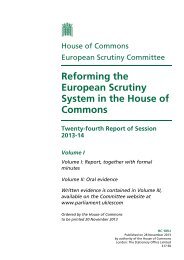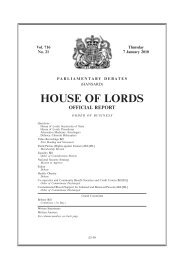here - United Kingdom Parliament
here - United Kingdom Parliament
here - United Kingdom Parliament
You also want an ePaper? Increase the reach of your titles
YUMPU automatically turns print PDFs into web optimized ePapers that Google loves.
1295W<br />
Written Answers<br />
6 JUNE 2013<br />
Written Answers<br />
1296W<br />
Table 1: Time in cell by prison establishment: average hours per prisoner per<br />
week day<br />
Establishment name 2007-08 2008-09 2009-10 2010-11 2011-12<br />
Wakefield 14.9 15.1 15.0 14.9 14.8<br />
Wandsworth 16.5 15.9 16.7 17.4 16.7<br />
Warren Hill 13.4 14.0 13.7 14.6 15.2<br />
Wayland 12.7 13.0 12.5 12.6 11.7<br />
Wealstun 12.5 15.8 15.7 16.5 15.7<br />
Wellingborough 14.0 15.1 15.4 14.2 15.0<br />
Werrington 13.7 13.7 13.5 14.3 14.8<br />
Wetherby 13.6 13.2 13.6 14.2 14.4<br />
Whatton 13.6 14.0 14.1 14.2 13.6<br />
Whitemoor 15.7 16.2 16.1 15.5 15.2<br />
Winchester 14.9 15.3 14.6 15.0 16.5<br />
Wolds 11.7 12.5 14.6 12.1 12.0<br />
Woodhill 15.0 13.4 14.7 15.0 14.5<br />
Wormwood Scrubs 15.1 15.8 16.1 16.8 16.9<br />
Wymott 13.4 15.2 15.4 15.5 15.5<br />
National Total 13.8 14.4 14.6 14.5 14.5<br />
Table 2: Time in cell by prison category: average hours per prisoner per week day<br />
Category 2007-08 2008-09 2009-10 2010-11 2011-12<br />
Category B 13.6 14 14.4 14.1 13.9<br />
Category C 13.1 14 14.2 14.2 14.1<br />
Dispersal 14.9 15.5 15 15 15.1<br />
Female closed 12.7 13.8 13.7 12.8 13.6<br />
Female local 12.4 13.2 13.6 13.5 14.1<br />
Female open 7.5 7.5 7.6 7.6 7.6<br />
Male closed<br />
14.9 15.8 16 15.8 16.2<br />
young offender<br />
Male juvenile 14.2 14.2 13.7 14.3 14.4<br />
Male local 15.2 15.6 15.7 15.5 15.4<br />
Male open 7.9 8.8 8.6 8.1 8.1<br />
Male open young 11.5 11.5 9.9 9 10.2<br />
offender<br />
Semi open 8.2 8.3 8.1 6 6.2<br />
Cluster — 12.7 13.2 14.5 14.5<br />
National Total 13.8 14.4 14.6 14.5 14.5<br />
Note:<br />
In the above table prisons are categorised according to their predominant<br />
function, though some establishments will have more than one function.<br />
Prisons: Employment<br />
Priti Patel: To ask the Secretary of State for Justice<br />
(1) how many jobs are available for prisoners in each<br />
prison in the UK; [156654]<br />
(2) what the participation rate is of prisoners in<br />
prison work schemes. [156754]<br />
Jeremy Wright: The number of prisoners working in<br />
industrial activity in public sector prisons increased<br />
from around 8,600 in 2010-11 to around 9,000 in 2011-12.<br />
These figures do not include the substantial numbers<br />
of prisoners who work within prisons on tasks such as<br />
cooking, serving meals, maintenance and cleaning.<br />
Figures are published in the NOMS Annual Report<br />
Management Information Addendum:<br />
https://www.gov.uk/government/uploads/system/uploads/<br />
attachment_data/file/163292/noms-annual-report-2011-12-<br />
addendum.pdf.pdf<br />
Data have been drawn from administrative IT systems.<br />
Although care is taken when processing and analysing<br />
the data, the level of detail collected is subject to the<br />
inaccuracies in<strong>here</strong>nt in any large-scale recording system.<br />
Priti Patel: To ask the Secretary of State for Justice<br />
(1) with reference to the answer of 25 April 2013,<br />
Official Report, column 1314W, on prisoners: pay, if he<br />
will estimate the (a) cost and (b) benefit to the public<br />
purse of employing prisoners instead of procuring<br />
services privately; [156780]<br />
(2) how many unskilled jobs in prisons are contracted<br />
out to private companies; and what the annual cost to<br />
the public purse is of procuring unskilled labour in<br />
prisons. [156862]<br />
Jeremy Wright: Substantial numbers of prisoners<br />
work on essential support tasks in prisons such as<br />
cooking, serving meals; grounds maintenance and cleaning.<br />
This provides significant work for prisoners and creates<br />
economic benefits to the public purse.<br />
Data are not held on the value of prisoner input to<br />
the delivery of particular services or the number of<br />
prisoners specifically involved in work that could otherwise<br />
be outsourced. The Department does not hold data<br />
concerning unskilled jobs in prisons.<br />
W<strong>here</strong> contracting out services is considered, maintaining<br />
prisoner input is an important factor to be taken into<br />
account—this could include prisoners working on behalf<br />
of a contractor.<br />
Probation<br />
Priti Patel: To ask the Secretary of State for Justice<br />
with reference to the answer of 25 March 2013, Official<br />
Report, columns 952-4W, on probation, how many offenders<br />
who failed to complete an accredited programme were<br />
subsequently (a) placed on an alternative programme,<br />
(b) ordered to retake the programme and (c) did not<br />
have to undertake any further accredited programmes.<br />
[156877]<br />
Jeremy Wright: It is not possible to answer this question<br />
in relation to the information provided in the answer of<br />
25 March 2013. This is because the figures provided in<br />
the earlier answer based on completions of the overall<br />
programme requirement and not instances of course<br />
attendance.<br />
The information provided earlier was based on aggregated<br />
completion rates for sex offender treatment programmes,<br />
domestic violence programmes and other offending<br />
behaviour programmes for each reporting year. These<br />
completion rates are calculated using a cohort method<br />
which tracks the outcome of individuals at either 12,<br />
18, 30 or 36 months after commencement, depending<br />
on programme type, and measures the proportion that<br />
completed. Failure to complete in this measure is defined<br />
as termination of the programme requirement either<br />
during or at the end of the order or licence. Both<br />
completers and non-completers included within the original<br />
answer may have dropped out of one or more courses<br />
and gone on to complete on another course, been<br />
placed on an alternative programme or failed to complete<br />
a further course. This level of information cannot be<br />
derived from the completion rate data.<br />
Training<br />
Priti Patel: To ask the Secretary of State for Justice<br />
how many officials in (a) his Department and (b) the<br />
non-departmental public bodies for which he is responsible
















